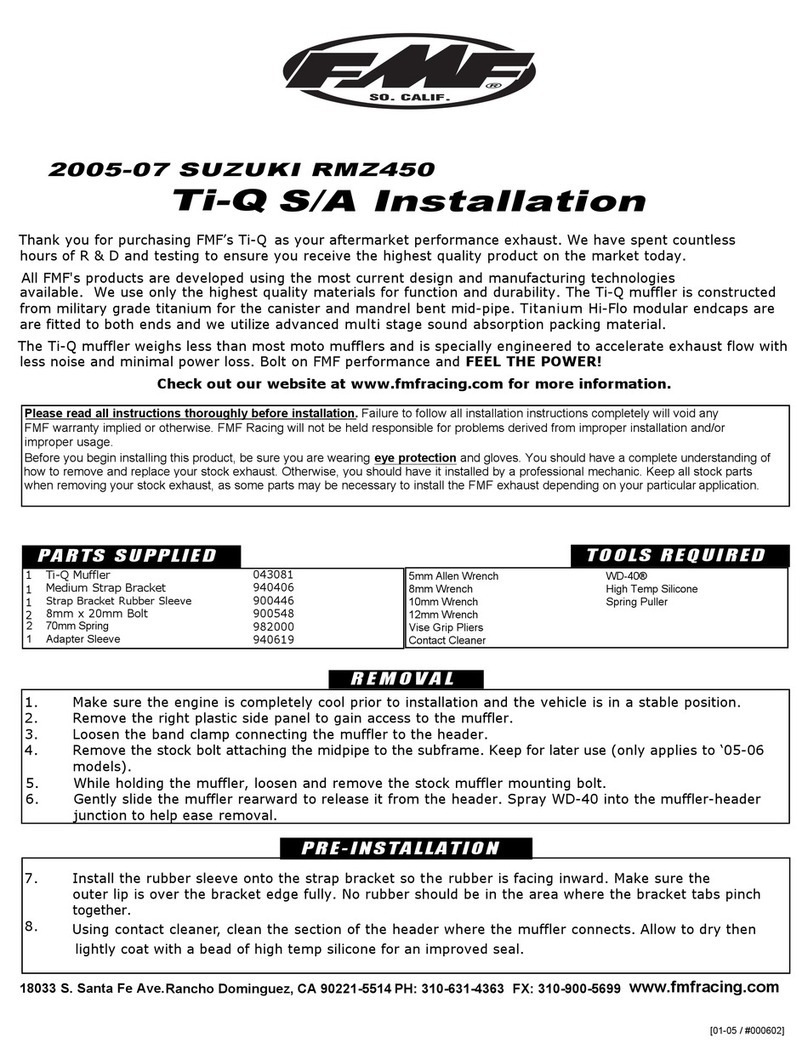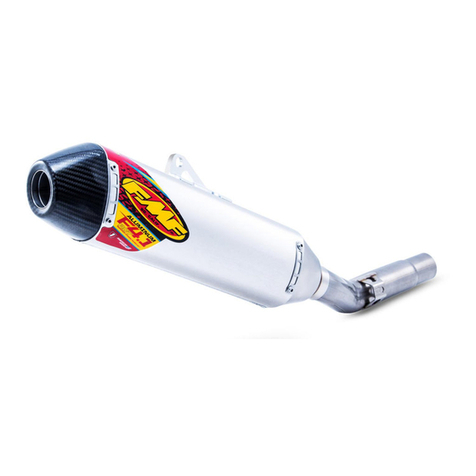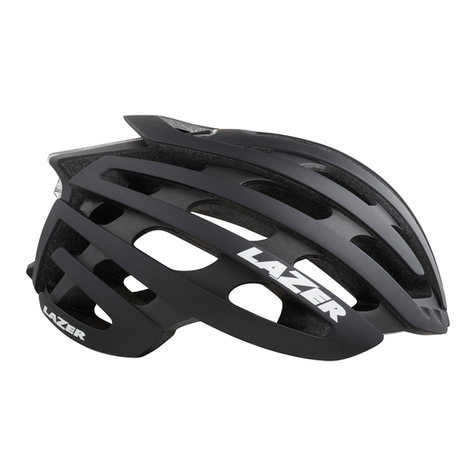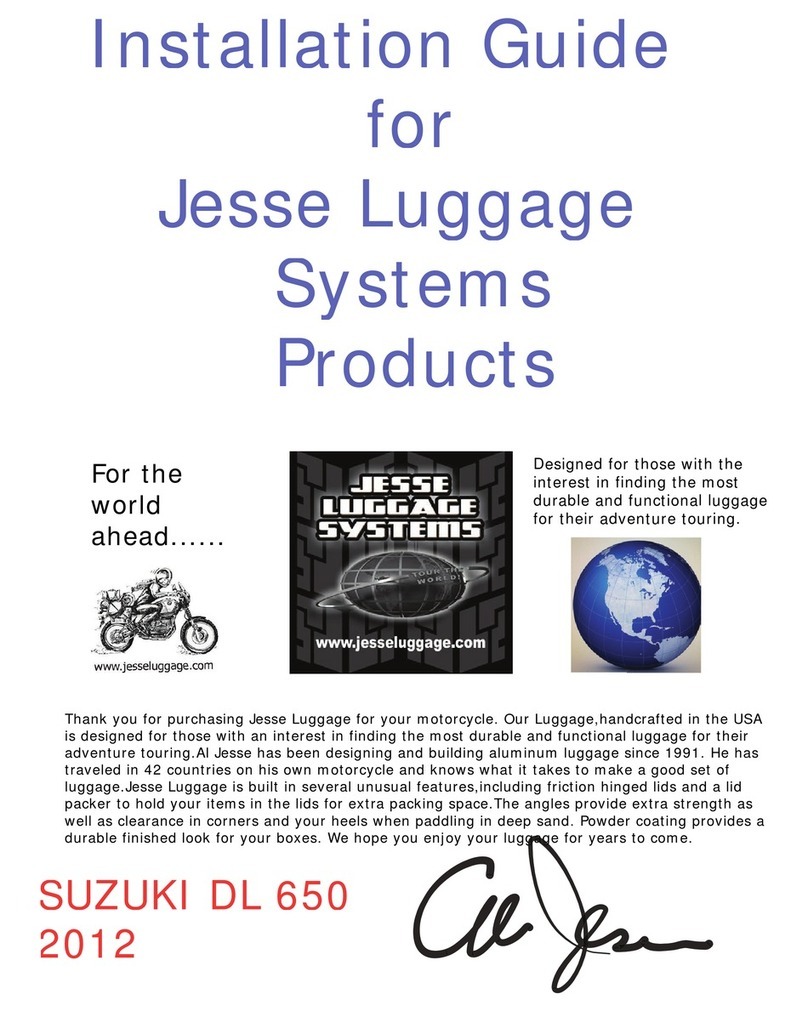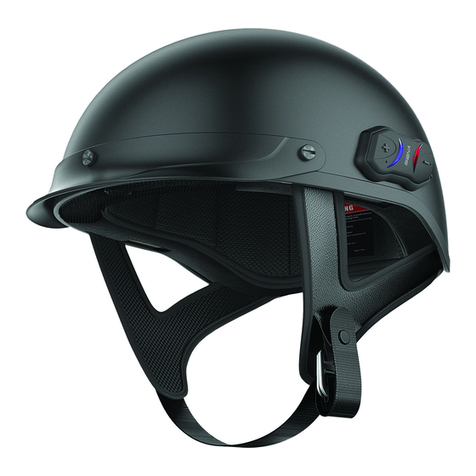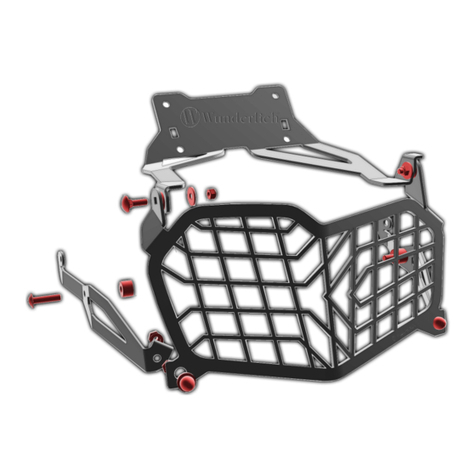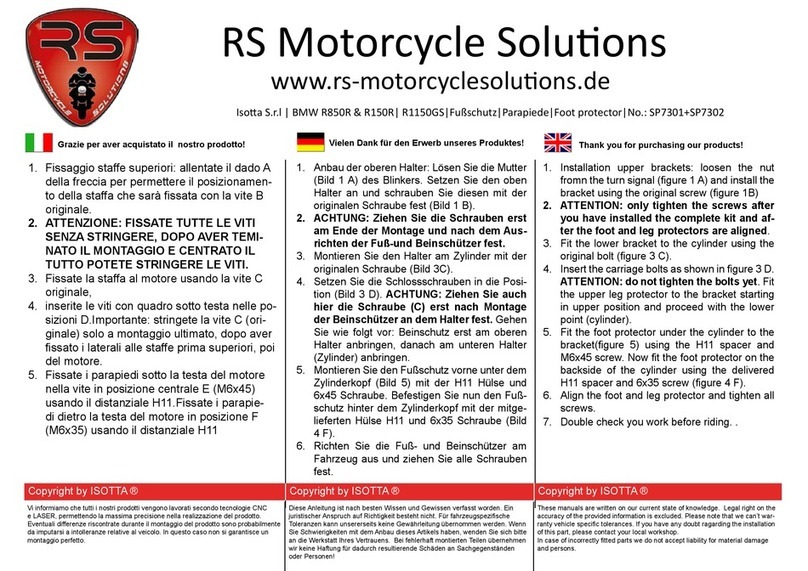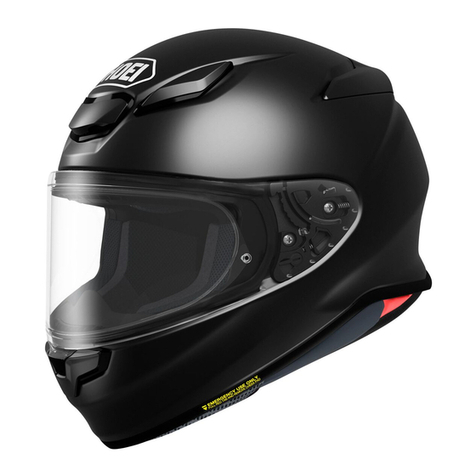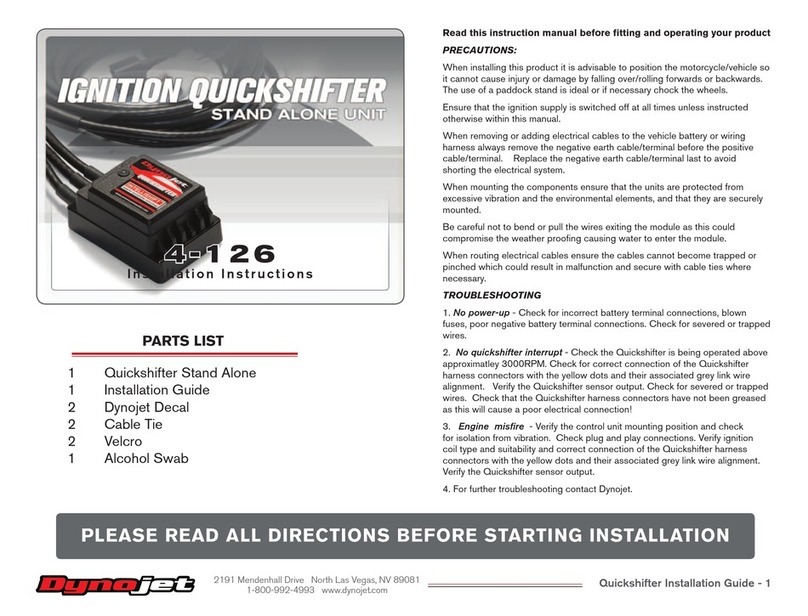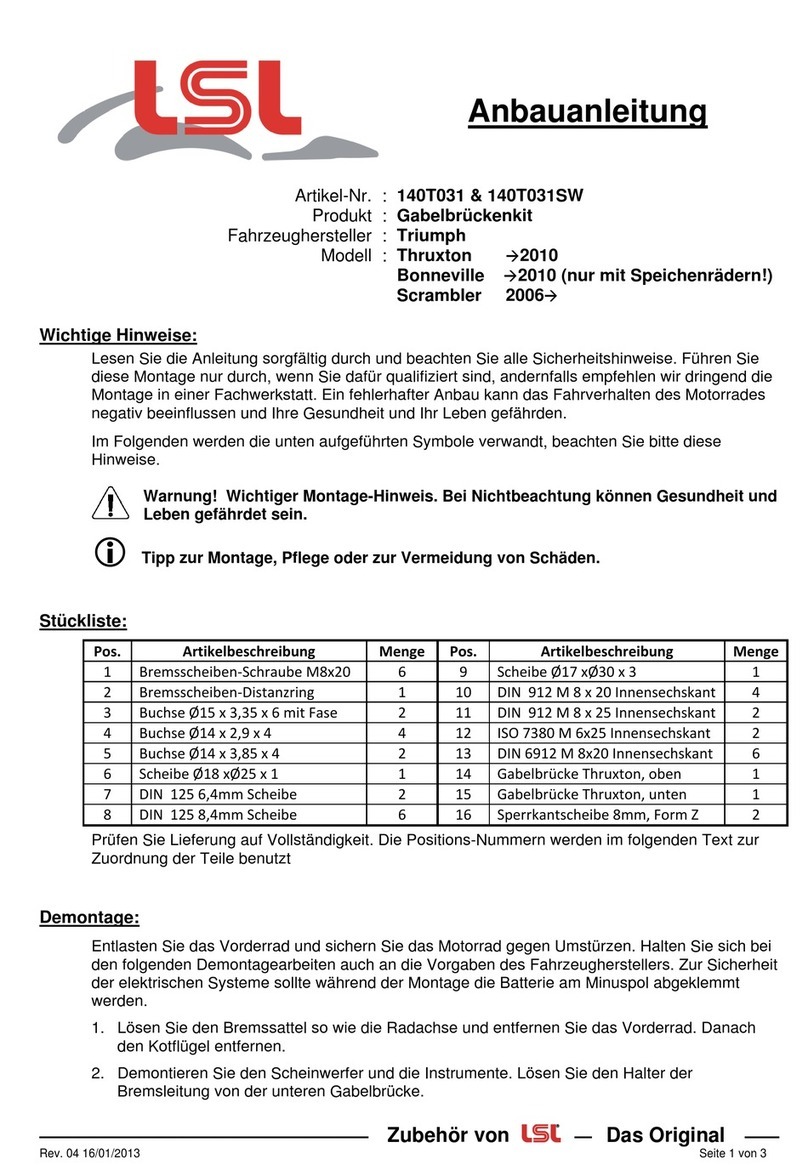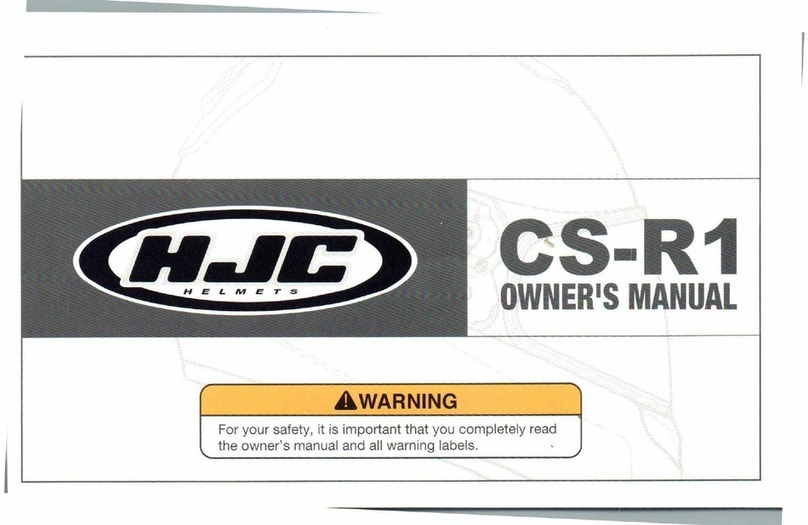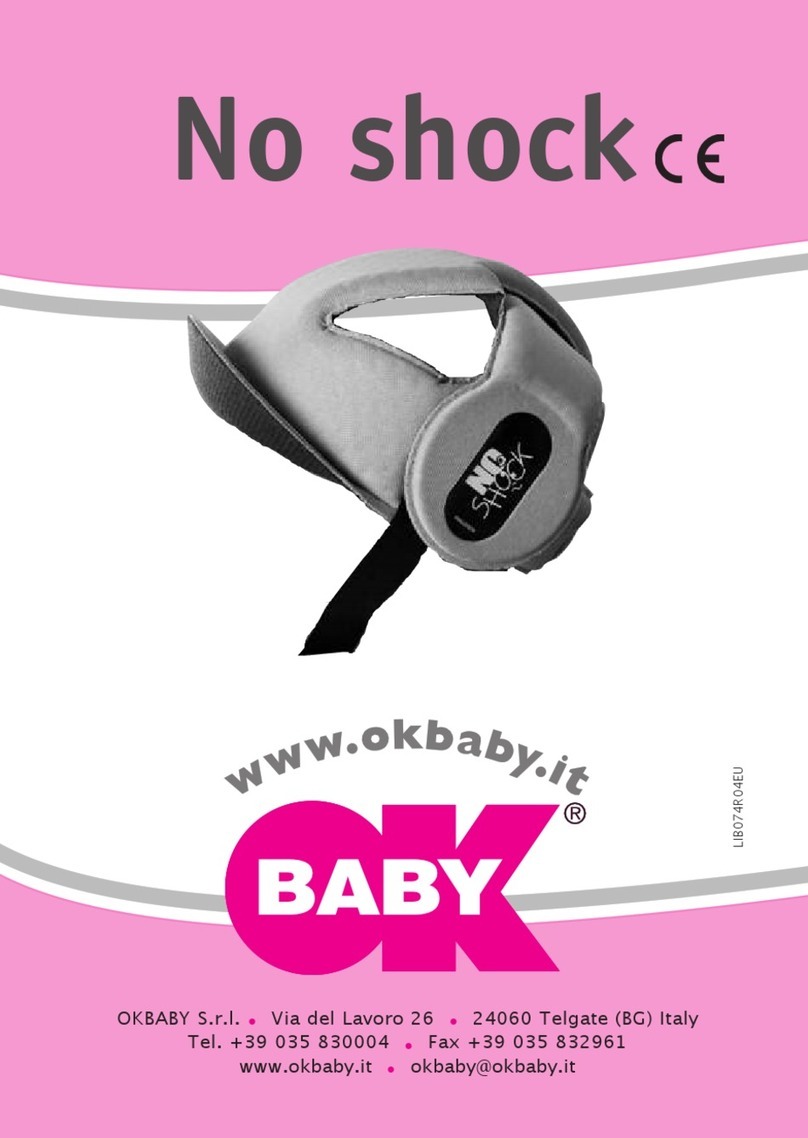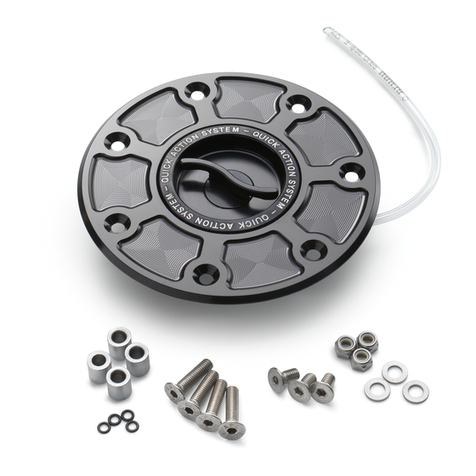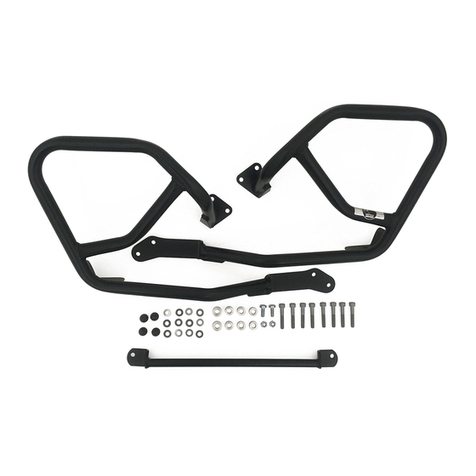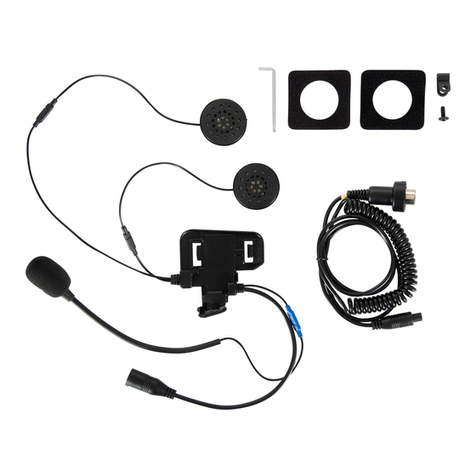FMF SUZUKI RM80 User manual

2-Stroke Pipe Installation
Thank you for purchasing an FMF pipe for your ride. We have spent countless hours of R & D and testing
to ensure you receive the highest quality product on the market today.
All FMF's products are developed using the most current design and manufacturing technologies available.
We use only the highest quality materials for function and durability. FMF pipes are manufactured from U.S. steel
and our Tru-Flo stamping process ensures quality control for fitment, reliability and unbeatable performance.
Whether it be Supercross, Motocross, GNCC, Desert or just plain old trail riding, with FMF you have a
choice. FMF pipes are engineered to have focused power gains to suit the needs of the rider under the conditions
they ride. Bolt on FMF performance and FEEL THE POWER!
Please read all instructions thoroughly before installation. Failure to follow all installation instructions completely will void any
FMF warranty implied or otherwise. FMF Racing will not be held responsible for problems derived from improper installation and/or improper
usage.
Before you begin installing this product, be sure you are wearing eye protection and gloves. You should have a complete
understanding of how to remove and replace your stock exhaust. Otherwise you should have it installed by a professional mechanic. Keep all
OEM parts when removing your stock exhaust as some parts may be necessary to install the FMF exhaust depending on your particular
application.
1. Make sure the engine is completely cool prior to installation and the vehicle is in a stable
position.
2. If necessary, remove the plastic side panel piece to gain access to the silencer.
3. Using a spring puller tool, remove the exhaust springs connecting the pipe to the exhaust port.
Keep for later use.
4. Loosen all mounting hardware on the pipe and silencer using the appropriate wrenches.
5. Remove the silencer from the subframe, keeping all mounting hardware.
*We recommend removing the silencer when installing a new pipe to insure proper fit and alignment.*
6. Remove the pipe, keeping all mounting hardware.
7. Remove any rubber grommets, o-rings or special hardware from the pipe.
8. Using contact cleaner, clean the exhaust flange and/or cylinder exhaust port to remove all dirt
and debris. If applicable, remove o-rings and clean the grooves of the pipe flange.
9. If your application uses an exhaust pipe washer/shim, make sure that is installed in the
cylinder before mounting the pipe.
R E M O V A L
OEM = Original Equipment Manufacturer
PRE-INSTALL ATION
TOOLS REQUIRED
8mm Wrench
10mm Wrench
12mm Wrench
Contact Cleaner
High Temp Silicone
WD-40®
Spring Puller
ATTENTION
This product is designed for closed course use only unless otherwise stated and not intended to meet emission regulations
for use on public lands, roads, or access routes - consult with local jurisdictions.

INSTALL ATION
POST-INSTALLATION
10. If applicable, install pipe o-rings using High Temp Silicone to provide a better seal. *We
recommend using new o-rings *
11. Loosely mount the FMF pipe with your existing hardware and make sure the pipe flange slips
fully into or over the cylinder flange. Wipe away any excess silicone.
12. Install new pipe springs. *We recommend using new springs and covering the springs with rubber
high temp hose if room allows to keep vibration to a minimum.*
13. Apply a thin layer of High Temp Silicone to the pipe where the silencer slips over.
14. With OEM pipe/silencer coupler in place, slide silencer over pipe and wipe away any excess
Silicone. Loosely install one silencer mounting bolt to hold it in place - do not tighten at this
time.
15. Make sure the pipe and silencer are in neutral positions and not binding. Slowly tighten all
mounting fasteners and clamps to OEM specified torque specs, starting from the front and
working your way back.
16. Inspect the complete exhaust to make sure there is no contact with the frame, shock spring,
engine, body panels or any cables, hoses or wiring. The exhaust system should only be in
contact with the exhaust port and mounting points. Confirm all controls operate in accordance
with OEM specifications.
17. We recommend using High Temp Silicone for an improved seal. Please follow instructions for
the Silicone and allow sufficient time to dry before starting the engine.
18. Before operating your vehicle, we recommend either stock jetting or installing our Power-Up Jet
kit for optimum performance on applicable models. Our jetting recommendations are to be used
as aguide only and were developed based on operation at sea-level at 70 degree ambient air
temperature. There are too many variables outside of FMF’s control to give you an exact
configuration. If you’re not able to tune the carburetor yourself, please find amechanic in your
area who is capable to take on this role. Refer to our website for more jetting information.
19. Start the engine and bring it up to operating temperature. Check for exhaust leaks.
20. Let engine cool completely and re-torque all mounting hardware to OEM specifications.
To clean your FMF pipe, allow to cool and use mild soap and water. Do not spray water onto a hot
exhaust. Dry completely to prevent streaking. Dry completely and follow up with a wipe down of WD-
40®to help reduce staining and rusting.
Aluminum wheel polish will help to keep the luster of nickel or chrome plating.
MAINTENANCE
DISCLAIMER: All products manufactured and/or distributed by FMF Racing are a) intended for use on stock vehicles specific to the U.S. market; b) for closed course use only unless
otherwise stated and c) not intended to meet emission regulations for use on public lands, roads or access routes – consult with local jurisdictions. FMF Racing makes no claims as to
the products applicability, effectiveness or fitment on modified machines. FMF Racing is the sole determines of abuse, misuse, installation errors and modifications. We assume no
liability for any errors in listings, specifications, part numbers, prices or model applications. We reserve the right to change specifications, product descriptions, product quality, pricing
and application at any time without notice and without further obligation. Buyer assumes all risk for any and all damage caused to themselves, a third party and/or property by virtue of
failure of these products. By installing and/or using an FMF product, you hereby accept and understand these stated terms and conditions and have followed all instructional steps.

SUZUKI RM80/85 JETTING RECOMMENDATIONS
Here are our jetting suggestions for your RM80/85. We’ve spent countless hours of testing to determine which settings work best
when bolting on one of our pipes and silencers to a stock machine. These are recommendations only, based upon our testing at
sea-level atmospheric pressure, a 65-80F degree ambient air temperature, a 32:1 fuel to oil mixing ratio on super unleaded
pump fuel with a stock motor.
For some models we offer a Power Up jet kit for optimum tuning. Kits may include jets, needles and any necessary hardware
and have been developed with the assistance of Dynojet.
There are too many variables outside of our control to give you an exact configuration that works perfectly under all conditions. Our
recommendations are just that, a starting point to reference from. Higher elevations, high humidity, hotter temperatures are examples that will
require leaner jetting. Colder temperatures are an example that will require richer jetting.
If you are unknowledgeable or don’t feel comfortable tuning your machine yourself, find a mechanic in your area who is. FMF Racing is not
responsible for problems derived from improper jetting and/or usage.
Always check that your jetting is correct when changing parts that could affect the intake system, exhaust system and any product or change
that could alter fuel combustion in the cylinder (ie. aftermarket ignition module).
Use the following suggestions when using a FMF Fatty, Factory Fatty, Gnarly, Rev or SST exhaust pipe.
Main Jet 122
2003
Pilot Jet 48
Needle STOCK
Clip Position 2ND
Air Screw 1.5 out
Main Jet 122
2002
Pilot Jet 48
Needle STOCK
Clip Position 2ND
Air Screw 1.5 out
Main Jet 195
2000
Pilot Jet 27.5
Needle STOCK
Clip Position 3RD
Air Screw 1.5 out
Main Jet 195
1999
Pilot Jet 27.5
Needle STOCK
Clip Position 3RD
Air Screw 1.5 out
Main Jet 195
1997
Pilot Jet 27.5
Needle STOCK
Clip Position 3RD
Air Screw 1.5 out
Main Jet 195
1996
Pilot Jet 27.5
Needle STOCK
Clip Position 3RD
Air Screw 1.5 out
Main Jet 195
1998
Pilot Jet 27.5
Needle STOCK
Clip Position 3RD
Air Screw 1.5 out
Main Jet 195
1995
Pilot Jet 27.5
Needle STOCK
Clip Position 3RD
Air Screw 1.5 out
Main Jet 195
2001
Pilot Jet 27.5
Needle STOCK
Clip Position 3RD
Air Screw 1.5 out

Main Jet 195
1994
Pilot Jet 27.5
Needle STOCK
Clip Position 3RD
Air Screw 1.5 out
Main Jet 200
1993
Pilot Jet 30
Needle STOCK
Clip Position 4TH
Air Screw 1.5 out
Main Jet 200
1991
Pilot Jet 30
Needle STOCK
Clip Position 4TH
Air Screw 1.5 out
Main Jet 200
1990
Pilot Jet 30
Needle STOCK
Clip Position 4TH
Air Screw 1.5 out
Main Jet 200
1989
Pilot Jet 30
Needle STOCK
Clip Position 4TH
Air Screw 1.5 out
Main Jet 200
1992
Pilot Jet 30
Needle STOCK
Clip Position 4TH
Air Screw 1.5 out
This manual suits for next models
1
Table of contents
Other FMF Motorcycle Accessories manuals
